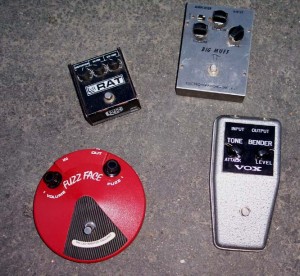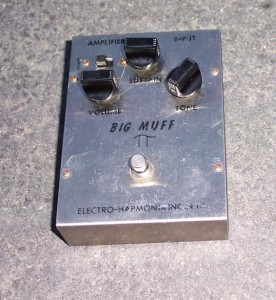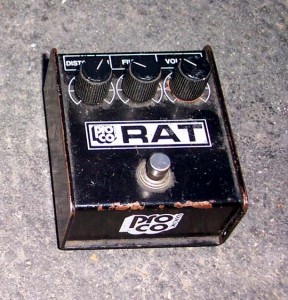I have a confession. As a guitarist for well over 25 years, I had always been an “anti-fuzz” person. In fact, I can honestly say I hated and despised the sound of fuzzes that I had heard. I couldn’t understand the point of purposefully making a guitar sound as atrocious and “lo-fi” as possible in mind. A fuzz tone after all, sounded nothing like an electric guitar should.
During this period of time, my search for the epitome of rock tone had to do with capturing rock guitar tones from the likes of players like Angus Young of AC/DC and of course Edward Van Halen. In my mind, any tone that deviated from those was simply bad tone, or at best, “sub-par.”
In hindsight, this thinking that I developed was a result of what I grew up on and heard at the time musically. For those older friends of mine that were players that grew up on Hendrix or Clapton – those seemed to be their favorite particular tones. Van Halen tone didn’t appeal to many of them as astonishing as I thought that was! To me, even those classic rock, Hendrix, Clapton, and Page tones were tones that I considered “mediocre at best.” To add to my youthful arrogance, while Van Halen’s or AC/DC’s tones were rather difficult to capture without the proper equipment and technique, I decided and assumed that many of the ’60s player’s tones (that I didn’t like anyhow) could be gotten by using any range of inexpensive guitars, pedals and amplifiers available. It just didn’t matter.
To fast-forward further in time to today’s high-gain tones you hear on programmed hard rock radio, to many “old timers”, the new sounds may appear bland, over compressed and sterile with no feel. Yet many people love them – that’s the sound they’re going for. It’s what the “kids” are growing up on today after all.
It’s interesting that only within the past few years of my adulthood have I felt I’ve come full-circle with my interest in tones. Whereas in the past for example I would think of the Maestro fuzz tone used on the Stone’s “Satisfaction” as pure garbage, I’ll admit now that I couldn’t imagine that classic tune being done any other way. There’s a charm to it. And there are countless other examples of really unique fuzz tones on record that go to fuzz extremes that are just wonderful examples of sonic colors. Iron Butterfly’s “In-A-Gadda-Da-Vida” is pure ’60s psychedelic fuzz, whereas the fuzz used on tunes such as Norman Greenbaum’s “Spirit in the Sky” sound as if the guitar and fuzz box in particular is about to break apart and die. That’s as unforgettable of a signature sound as any especially and part of what gives that tune its charm.
Or what about Neil Young’s “Hey Hey, My My (Into the Black)”, a true rock classic with a tone that I once described to myself as, “THE worst recorded guitar tone of all time” with its overloaded extreme “Big Muff on additional steroids” sound? I listen to it now with a smile on my face. It’s different, and I can appreciate that!
Not all fuzz use was so extreme in its tonal results. There are many countless examples of recorded tracks through time that used vintage fuzz boxes that sounded great by traditional standards of thought. Jimmy Page’s use of fuzz on the first Led Zeppelin albums helped create pure sonic landscapes. And of course there’s David Gilmour, using an early silicon fuzz face for some of the great tones he captured on Pink Floyd classic albums such as “The Dark Side of the Moon” or “Meddle”. You can go back to the Beatles or move forward to contemporary groups like U2, Radiohead and a myriad of others to find great examples of fuzz use.
In the end, variety is the great spice of life. Imagine if each of us was so close-minded as I was back in the early days with my thought that solely thinking that a humbucker-equipped guitar straight into a Marshall was the only good tone available – what a boring world we would live in!
What is Fuzz?
Fuzz, in comparison to overdrive or distortion effects can best be described as a hard-clipping effect where in its most simple form is a type of distortion created by two or more simple transistors. The earliest fuzz units used germanium transistors that contributed to quite a unique sound that silicon transistors, op amps, or tubes can’t seem to mimic.
A fuzz loaded with germanium transistors will be capable of a varying degree of frequency response and gain. While some germanium fuzzes will have a narrow frequency response band that hovers in the midrange, others can be quite balanced in comparison and have a wider frequency response. By adding additional germanium transistors in a circuit, some fuzzes were made that are capable of extreme amounts of gain as well.
made that are capable of extreme amounts of gain as well.
What germanium fuzzes have in common generally is a particular raspy or rougher sound mixed in with harmonic overtones that are very apparent and musical especially when blended against an already overdriven tube amplifier. With an amp already compressing its tube in an overdrive state, germanium fuzzes can really take on a life of their own and sound completely different than when run against an amplifier set clean. Listen to the sound of early live Hendrix as he wails his solos through his Marshall stacks – the overall thickness and sustain is a blend of a Fuzz Face effect in addition to the compression of the Marshall. This created quite an explosive sound and was unheard of in its day.
Silicon transistors emerged in popular use in the late ’60s as they were easier to manufacture in terms of consistency of performance and reliability. Early silicon fuzz units had a notably smoother sound with much of the raspy-effect now gone. Silicon units were also capable of higher gain when comparing otherwise identical circuits and also had a much wider frequency response.
During the ’70s, the transistor was replaced by the IC, or integrated circuit, which basically held the job of multiple transistors on one chip. Some fuzz purists may feel that at that point, IC-based units could no longer be considered “true” fuzz effects.
Today, there are a wide range of fuzz units on the market, both old original designs, reissues of those originals, as well as some unique new fuzz tones and even “hybrid” units that blend the characteristics of overdrives and fuzz units. What is offered ahead are some glimpses of these fuzzes with my best job to describe these units without personal judgment (i.e. there will be no “Fuzz X is better than Fuzz Y).
While I typically have my opinions on just about everything we see at Legendary Tones, in the case of fuzz units, the tones are so different and what may be considered great by one person, may be thought of as garbage by another. So with that I will describe each fuzz unit as well as I can so that you the reader can be better equipped to make the final choice if one of these fuzzes interest you. Think of this as an introduction to the flavors of fuzz, and just like certain people will prefer chocolate over vanilla ice cream, we can’t say which is one “better” per se. They’re all different and unique and characteristically fun.
I’ve included some vintage units as well here as many of these are considered the classics and are a the influence and starting point by which other fuzzes later were developed. I am only considering the ones that we had or have here in house to play ourselves – I do realize that a few of the classic models are missing from the list. Perhaps we’ll do another round at another time.
In the end what is fun with these old vintage units is that many of these fuzzes are just as musically valid and useful today as they were when they were first brought to market decades ago. Even for the moderate fuzz user, fuzzes make a great special effect to throw into one’s music for variety from time to time!
I hope you enjoy the Fuzz Feast!
Vintage Fuzz Pedal Hors D’oeuvres
1966 Vox Tone Bender
 The oldest fuzz in our collection, this 1966 Vox Tone Bender was made famous by that group of British lads known as the Beatles. This unit is a simple design, uses two germanium transistors and is built, and feels like, a tank.
The oldest fuzz in our collection, this 1966 Vox Tone Bender was made famous by that group of British lads known as the Beatles. This unit is a simple design, uses two germanium transistors and is built, and feels like, a tank.
The sound of the early Tone Bender is a cross between a device like a Dallas Rangemaster treble booster and a Fuzz Face. At maximum fuzz settings, it has a little bit less fuzz than an early germanium-equipped Fuzz Face. In addition, the frequency response curve and output of the unit emphasize the upper frequencies more so than any Fuzz Face, whether germanium or silicon. The resulting tone when cranking up the fuzz control (appropriately labeled “Attack”) is a very raspy-sounding fuzz that is very pronounced and aggressive on the top end. In some applications such as using it against a brighter amplifier, the Tone Bender may be considered a bit much for the ears to take as it can easily be made to sound like a piercing buzz saw. I suppose the Vox folks warned us with the “Attack” label however…
But interestingly enough, using the Tone Bender with a cranked up Vox AC-30 which can then produce a lot of low-end and compression courtesy a quartet of EL84 tubes, the Tone Bender makes a nice solo lead boost to use to and balances the overall tone nicely. And in another application, when using the Tone Bender through a Vox AC-30’s Brilliant “Top Boost” channel and cranking it up, the fuzz tone is very psychedelic ’60s in flavor and buzz.
Not surprisingly, when using the Vox Tone Bender through an amp set purely clean, the fuzz tone is very crunchy, with medium gain, and again with an emphasis on a lot of mid and high-end bite.
1970 Dallas Arbiter Fuzz Face
This nice red Fuzz Face with its original beat-up box is actually among the very first incarnations of a silicon-equipped Fuzz Face and uses a pair of BC108C transistors. A silicon fuzz face in general will sound quite a bit different from the earlier germanium models. If you like the raspier-fuzzy sound, germanium is the way to go. To contrast, if you like the smoother overdriven-type tones that are a bit more fluid-sounding, a silicon-loaded Fuzz Face may be your preference.
Though the original Fuzz Faces with germanium transistors are the most valued by collectors and players, the silicon versions aren’t far behind them and in fact many high-profile players have used and actually preferred the silicon versions.
The most-famous of silicon Fuzz Face users was of course Jimi Hendrix, who switched over to a silicon fuzz during his “Band of Gypsies” era and continued its use until his untimely passing in September of 1970. Other well-known users of silicon Fuzz Face units include Eric Johnson, as well as David Gilmour of Pink Floyd.
This particular Fuzz Face (dated July 1970 on the potentiometers) has quite a bit of gain when turned up and is very sensitive between it’s ¾ up to full fuzz settings. The BC108C transistors are noted for being very heavy in gain. It is a darker sounding fuzz overall, with the emphasis being on the upper-low range frequencies as well as the mids. When using the Fuzz Face through a brighter amp, it can even out the tone a bit while also adding its own element of violin-like sustain. Sonically, this Fuzz Face when compared to our Vox Tone Bender, can really be thought of as a night and day comparison. They are nothing alike.
1971 Electro-Harmonix Big Muff Pi
The Electro-Harmonix Big Muff Pi emerged in the early ’70s as quite a radically-different sounding fuzz. The Big Muff has gain – and lots of it. Big Muffs were always silicon-based and early units such as this (known in some circles as the original “triangle-knob” version) also found favor by many pro players.
From Carlos Santana, to David Gilmour, to the Smashing Pumpkins, and countless others, the earliest Big Muffs found a dedicated camp of users. And did we mention this unit has a ton of gain? Not just gain, this is a big, wooly-feeling fat gain.
 The Big Muff was also among the first (if not the first) fuzz unit that had such a huge sound with a very wide frequency response. This is what it is quite famous for in fact. Thick bottom end and all the treble bite you could ask for and a control labeled “Sustain” that didn’t lie.
The Big Muff was also among the first (if not the first) fuzz unit that had such a huge sound with a very wide frequency response. This is what it is quite famous for in fact. Thick bottom end and all the treble bite you could ask for and a control labeled “Sustain” that didn’t lie.
The tone control on Big Muffs in general operate very differently as well. At one side of the tone setting is a very dark bass tone that easily goes to mud. On the opposite side of the tone control is a sharp high end that is pure psychedelia. The early reference to Iron Butterfy comes to mind as that sound can be captured when using the Muff to its extreme treble. When moving the tone control back toward the middle zone, one can often find the sweet spot that makes these Big Muffs so characteristically unique.
Not surprisingly, with so much sustain and gain on tap, the Big Muff sounds best to most people when used against a cleaner-amp. This is the opposite of the earlier fuzzes, which do best when used in conjunction with an already overdriven tube amp section. If you’re brave enough to run a Big Muff against an overdriven amp, expect quite a bit of noise and hiss, but some interesting overtones as well.
1982 Pro Co. Sound Inc. RAT
David Gilmour sure likes his pedals – we can note him as another famous user of the Rat pedal in addition to Jeff Beck among others. It’s interesting to note that the circuit designer of the Rat, according to the book “Stompboxes”, by Art Thompson, came across much of the design and unique sound of the Rat by mistake. He apparently missed a color code on a resistor band and the circuit still worked and the resulting tone is history.
The Rat is similar to a Big Muff except it is a quite a bit more focused and tighter in its distortion feel. It has a wide frequency response when compared to our Tone Bender, but is a little more narrow than a Big Muff. Our Pro Co. Sound Inc. Rat really was considered THE “Marshall-in-a-box” sound in its day.
And though its fuzz control is labeled “Distortion”, it was first marketed as the be all-end all fuzz unit. Early advertising promised the Rat would, “Distort like Hell”. Some consider the Rat more of a distortion box rather than a fuzz, but since there is some debate on this topic, we thought to include it here regardless. It has certainly earned its keep over the years regardless of how one classifies the Rat and there are some great sounds that can be found within this small steel box.
And while the Rat does have a big low end similar to the Muff (no debate on the Muff’s classification as a fuzz) the Rat does feels a bit more controlled and faster on the attack. Perhaps not the perfect comparison, but where the Big Muff brings to mind looser thicker “stoner rock” heavy sounds when playing it at higher gained settings, the Rat feels more like the ’80s-metal side of the house.
Also similar to the Big Muff in another respect, this fuzz (distortion?!) seems to do best working on its own against a cleaner amp when using higher gain settings. However, turning the distortion down on the Rat can produce some mellower sounds that are effective to juice up an already overdriven amplifier. Our own early Pro Co Sound Inc. version of the Rat is surely beat up after years of service but isn’t going anywhere – it sounds great.
That’s a Wrap for Part 1
Each of these older fuzz units used in our introduction have their own unique character in how they sound and especially how they respond to one’s playing. Each also will have a different sound – in some cases radically so – depending on the gear that accompanies the fuzz. Because of this, some may consider fuzzes as being “picky” about what they’re being used with to get certain tones. Certainly finding the right fuzz can be a challenge because of this, but once you’ve got the taste for the one that works for you, they’re quite cool tone shapers.
In Part 2, we’ll look at a large assortment of today’s latest fuzz offerings. From fuzz clones, to reissues, to limited editions, and hybrid-fuzz units, we’ll prepare for the main course of our Fuzz Feast and do our best to outline their special attributes and tones.